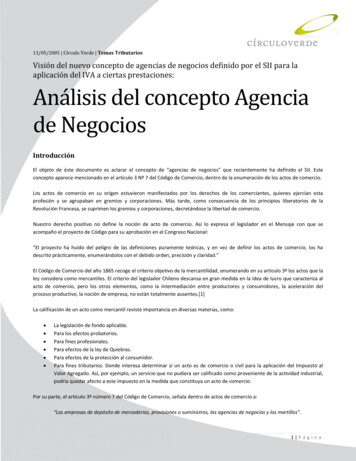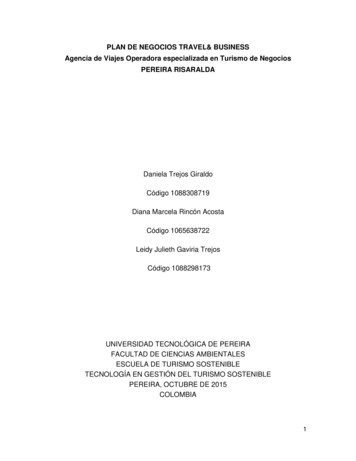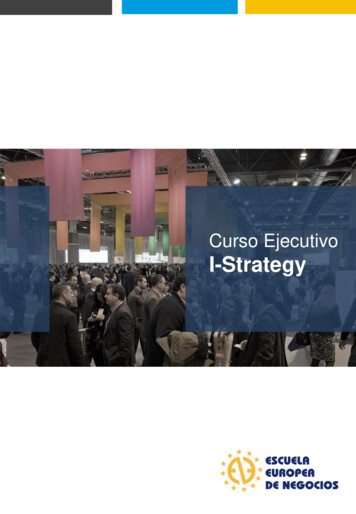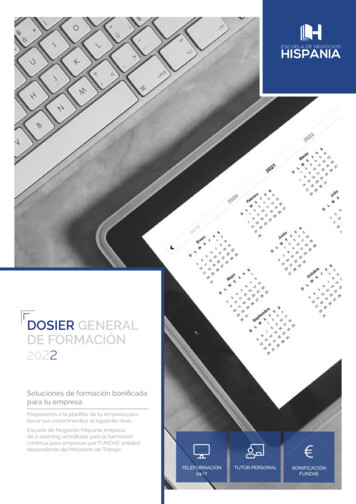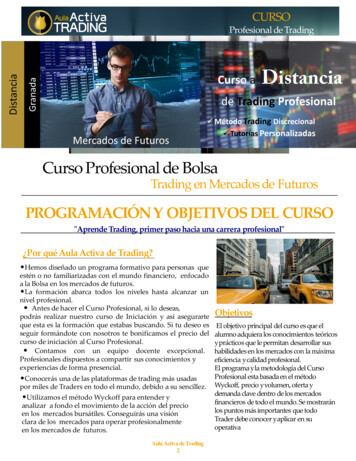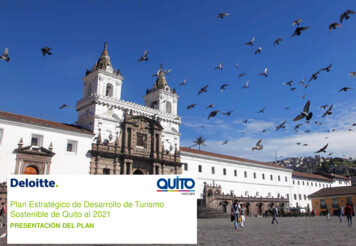
Transcription
Mercados y Negocios1665-7039 printed2594-0163 onlineYear 23, N. 46, May-August (2022)Omnichannel Marketing Model Applied at the ShoppingCenters in Medellín CityModelo de marketing omnicanal aplicado a centros comerciales en la ciudadde 725María Isabel Rodríguez SalazarFundación Universitaria Autónoma de las Américas aisabelrodriguez1036@gmail.comReceived: December 7, 2021Accepted: March 8, 2022ABSTRACTThe main objective of this research is to form an omnichannel marketing model applied atthe shopping centers in Medellín city. For this, a qualitative methodology was applied. Two(2) focus groups with shopping center customers, two (2) in-depth interviews with experts inOmnichannel, Sandiego Shopping Center case study, and a theoretical review were carriedout to obtain the fundamental components of the omnichannel marketing model applied tothis category. The model is proposed in a circular structure, made up of orbits that revolvearound the Omni-client. The model is made up of the consumer's journey, from 5A; the levelsof transparency, coherence, and fluidity based on: ( ) Greater consistency ( ) Greaterloyalty; and the levels of online and offline interaction, which are transversal in the entireproposal of the model.Keywords: Omnichannel marketing; Omni-client; consumer journey; shopping centers;retail; online; offline.JEL Code: M3, M31.Mercados y Negocios por Departamento Mercadotecnia y Negocios Internacionales. Universidad de Guadalajara se distribuye bajo una Licencia Creative Commons Atribución-NoComercial4.0 Internacional.Basada en una obra en http://revistascientificas.udg.mx/index.php/MYN/.
Omnichannel Marketing Model Applied at the Shopping Centers in Medellín IityRESUMENLa presente investigación tiene como objetivo principal formular un modelo de marketingomnicanal, aplicado a la categoría de centros comerciales de la ciudad de Medellín. Para ellose aplicó una metodología cualitativa, donde se realizaron dos (2) grupos focales con clientesde centros comerciales, dos (2) entrevistas a profundidad con expertos en omnicanalidad,estudio de caso del Centro Comercial Sandiego y una revisión teórica, a fin de obtener loscomponentes fundamentales en un modelo de marketing omnicanal, aplicado a estacategoría. El modelo propuesto se plantea en estructura circular, conformado por orbitas quegiran alrededor del omnicliente. El modelo está constituido por el recorrido del consumidor,desde las 5A; los niveles de transparencia, coherencia y fluidez basados en: ( ) Mayorcongruencia ( ) Mayor lealtad; y los niveles de interacción online y offline, que sontransversales en toda la propuesta del modelo.Palabras clave: Marketing omnicanal; omnicliente; recorrido del consumidor; centroscomerciales; retail; online; offline.32PAGE \*MERGEFORMAT14Código JEL: M3, M31.MERCADOS y Negocios
Rodríguez, M.INTRODUCTIONThe shopping center industry has based its business focus during the last decades onconstructing physical experiences. However, due to the digital transformation and,specifically, the crisis caused by the pandemic (covid-19), the vast majority of shoppingcenters in Colombia and the world had to close their doors for several months. At this point,the question began to be asked: "how to reach our customers?". An industry that was alwaysready to receive them in person should now reach their homes digitally.The opening of the shopping centers revealed that the digital transformation was alsoimmersed in this sector. Consumers had changed, now with greater demands and accustomedto having solutions at a click, without the need to mobilize. This transformation primarilyimplies a social change, which involves the behavior of people and organizations and therelationships between them and objects (Rey, Lirola and Mato, 2017).This study starts from the accelerated growth of digitization and digital density, representedby mobility, social networks, big data, the cloud, the Internet of things, emerging electroniccommerce, and the changes in the category of shopping centers.PAGE \*33MERGEFThe study's main objective is to formulate an Omnichannel Marketing Model applied to theORMAT1shopping centers category in Medellín city. For this, the critical question is: what components 5should an omnichannel marketing model have to be implemented in the shopping centers ofMedellín city?To arrive at the formulation of the model, we start by determining the fundamental variablesthat compose it and identify the implementation tactics in an omnichannel strategy from amarketing perspective. Next, find the minimum parameters that a shopping center mustconsider implementing an omnichannel marketing strategy; establish the principal momentsof truth in the consumer's journey and how his journey is throughout the model.This model will allow shopping centers to guide their marketing strategies based on theircurrent consumers, building on contact portals and creating consistent experiences acrossonline and offline channels.Year 23, N. 46, May-August (2022): 31-56
Omnichannel Marketing Model Applied at the Shopping Centers in Medellín IityTHEORETICAL FRAMEWORKThe road to omnichannel“The concept of customer experience is generally defined as the customer's multidimensionalresponses (cognitive, emotional, sensory, behavioral and relational) in the service of acompany” (Siebert et al., 2020)Consumers today tend to use more channels and touch points with brands during their buyingjourney. For this reason, in each phase of the journey, whether in search, purchase, or postpurchase, customers mix channels (Weinberg, Parise and Guinan, 2007). These are when thechannels become the critical contact points where the brand can interact with its consumers.(Mosquera, Olarte and Ayensa, 2017)The combination of new sales formats, the application of new information andcommunications technologies (ICT), changes in the environment, and the socio-culturalconditions of people, have led to a transformation of the behavior of the individual throughoutthe entire consumer journey (Frasquet, Mollá and Ruiz, 2012).34PAGE \* This evolution in consumer behavior is accompanied by the increasing complexity of theMERGEF purchasing process (Mosquera et al., 2017). It means a mandatory challenge for companies,ORMAT1 which invites them to seek new forms of management for their businesses and thus compete4in the new commercial environment, where being single-channel is not enough.Today, companies at the forefront apply Inbound marketing, a methodology that combinesnon-intrusive marketing and advertising techniques, to create valuable experiences thatpositively impact their consumers and users (Moriuchi, 2021; Holden, Salinas and Zhang,2021). The main objective of this method is to attract prospects and customers throughrelevant content, having customer/consumer satisfaction as its core and rotating in the cycleof attraction, retention, and delight.Companies are being forced to develop digital marketing strategies to stay current. At thispoint, omnichannel makes all the sense, to the extent that the simultaneous use of differentcommunication and purchase channels for consumers is promoted (Kotler, Kartajaya andSetiawan, 2019).Thanks to the internet, smaller brands and businesses no longer face the logistical constraintsthey faced in the past. As a result, marketing has ceased to be vertical to become horizontal,and in this new model, we speak of empowered consumers (Kotler et al., 2019). In this way,the form of vertical market, known by some authors as dominant, has evolved towardsMERCADOS y Negocios
Rodríguez, M.horizontality to be free; here, consumers have the power to condition companies to developproducts and/or services.At the same time, horizontality forms a more inclusive market, where a multilateral powerstructure prevails that gives value to the options of buyers and consumers (Kotler et al.,2019). Therefore, it is valid to differentiate that buyers execute the transactional action. Atthe same time, consumers do not necessarily take part in purchasing but are directly linkedto consuming of the product, experience, or service.Now, talking about Omni-clients, also known as online and offline consumers, is a primaryissue when thinking about the design of omnichannel marketing models for businesses.Kotler (2018) highlights that each consumer has the freedom to build an individual shoppingexperience. They can take their journey as buyers by combining different contact channelswith a particular brand, and the order they want.The combination of new sales formats responds to a channel integration strategy, whichprimarily seeks to reach more consumers and provide them with complete and satisfactoryshopping experiences. The omnichannel strategy responds to a transformation in thepurchasing behavior of consumers and, in turn, highlights an evolution in their purchasinghabits and the forms of contact they seek with brands. (Kotler et al., 2019).PAGE \*35MERGEFCurrently, it is usual to find brands that include different channels in the purchase process inORMAT1their marketing strategy, the above to reach different consumer segments and have a greater 5breadth in their market (Acquila, 2019).The Omni-customer and omnichannel marketing“To develop a good omnichannel marketing strategy, companies have to perceive theconsumer journey with a higher level of detail.” (Kotler et al., 2019).Following the previous premise, today's consumer finds different possibilities of contact withbrands. With this variety of possibilities, various channels offer the opportunity to receiveshopping experiences.A study carried out by the International Data Corporation (2020) shows that the amount andpersistence of Omni clients exceed that of single-channel (single-channel) consumers by30%. Therefore, it is worth highlighting the relevance of this type of marketing and thepossibilities it generates for consumers and brands. In this scenario, the role of socialnetworks cannot be ignored. Which become a valuable and necessary tool to build horizontalrelationships; they remove geographic and demographic barriers, facilitate communicationbetween companies and drive innovation in companies (Kotler, Setiawan and Kartajaya,2010).Year 23, N. 46, May-August (2022): 31-56
Omnichannel Marketing Model Applied at the Shopping Centers in Medellín IityUnderstanding how people buy is a very granular task, and for this understanding, theroadmap will always be mediated by the buyer's journey. This model was previously knownas AIDA, a scheme with a proposal focused on the purchase: Attention, Interest, Desire, andAction. With author Derek Rucker of the Kellogg School of Management, the scheme wentfrom AIDA to becoming the 4 “A” model: Attention, Attitude, Action, and AdditionalAction. This change responds to the need to monitor the consumer's post-purchase behaviorto evaluate retention. The 4 “A” model is an essentially personal journey since the mostsignificant influence on the purchase decision comes from the contact points that the brandhas to connect with the consumer; in theory, all these factors can be controlled by theorganization.New buyer's journey in the age of connectivityToday, we find a buyer's journey known as the 5As: Aware, Appeal, Ask, Act and Advocate.However, first, let us see a brief explanation of each phase:-36PAGE \*MERGEFORMAT14----Aware: this phase is the gateway to the consumer journey; there, consumers areexposed to a long list of brands, communication messages, and different media. Inaddition, from the memories built from previous experiences with the brands and thepositive or negative comments they have received from others (Kotler et al., 2019).Appeal: after the consumer is aware of the existence of several brands, the differentadvertising messages of the same are processed, and this is how short-term memoriesare created, amplifying their remote memory (Kotler et al., 2019). At this point, theprocess of attraction occurs.Ask: when the consumer is curious about a brand, the asking phase takes place, wherethe consumer investigates the brand(s) of their interest through different channels,both online and offline. In this phase, the consumer journey goes from beingindividual to becoming social. Their decisions are primarily based on information thatthey extract from external factors, including friends' recommendations and/orcomments on other customers' experiences.Act: when the information found by the consumer is clear and attractive to him, thepurchase action occurs. It is essential to understand that the purchase is not the onlyaction that it seeks. For example, in the shopping centers, the necessary action is thevisit and the relationship with the Brand.Advocate: the journey does not end with the purchase; on the contrary, a new pathbegins here: the advocate, where the Brand's recommendation is given and, therefore,the consumer's loyalty. This phase reflects the feeling of loyalty that consumers havetowards a brand. (Kotler et al., 2019)MERCADOS y Negocios
Rodríguez, M.After having a context of each phase, the Consumer Journey Map is presented through the 5“A”, proposed by Kotler et al. (2019) in his work Marketing 4.0 Transform your strategy toattract the digital consumer (Table 1).Table 1. Map of the consumer journey through the merTouch KACTADVOCATECustomersdecide to buyand interactwith the brandOvertime,customersmaydevelop a sense ofloyalty to thebrand. Repurchaseandrecommendationat best.Consumersprocess messagesto which they areexposed.Call a friend foradvice,searchonline,phone,shop,compareprices Purchaseonline or instore, use theproduct, aftersales service.Continuity in theuse of the Brand.Recommendationandcommunication ofthepositiveexperience withthe brand.I’MCONVINCEDI’MBUYINGIRECOMMENDCustomers aremassivelyexposedtobrandsandrecommendations of others.-Learn about tising.-RecallexperienceI KNOWCustomersprocessthemessages they areexposed,tocreatingshortterm memory.-Become attractedto brands.-Createaconsideration setof brandsI LIKECustomers amily.Source: Own elaboration (Kotler et al., 2019).The consumer journey from the perspective of the 5 A's is a flexible model that can beadapted to different sectors. It is essential to clarify that this route is not always linear. Inmost cases, it takes place in the form of a spiral; for this reason, the map is a guide to thephases, but it does not represent a linear model (Kotler et al., 2019). The exercise of eachbrand is to understand the different types of journeys that its consumers carry out, to interactdirectly with its brand.As a result of the new digital technologies, the archetype of an omnichannel consumer,known as an Omni-client, emerges. For example, who expects a brand to be able to offer itsservices through various channels; they also want to have consistent experiences whenswitching between the channels provided by the omnichannel business or brand (Gao et al.,2021). In other words, when interacting with an omnichannel business, this type of consumerexpects the online experience to be consistent with the offline experience.In an omnichannel shopping landscape, customers use online and offline channels tocomplete their purchase process and thus obtain the product, service, or experience they wantYear 23, N. 46, May-August (2022): 31-56PAGE \*37MERGEFORMAT15
Omnichannel Marketing Model Applied at the Shopping Centers in Medellín Iity(Gao et al., 2021). For this reason, the online customer experience and the offline customerexperience are critical components within an omnichannel strategy, as both contexts arereflected in the overall Omni customer experience. The research developed by Gao et al.(2021) shows that companies must consider the variations given in the customer experience,through the different online and offline channels, to provide their consumers with a congruentshopping and relationship experience with the brand. Here is the omnichannel experiencemodel created by the authors mentioned above (Figure 1).Figure 1. Omnichannel Strategy Conceptual OnlineCustomerExperience38PAGE \*MERGEFORMAT14( )OfflineCustomerExperienceChannelConvenience( )Incongruence Effect(-)ChannelSeamlessness( )CustomerRetentionSource: Gao et al. (2021).The main challenge marked by the presented model is managing and balancing the existingrelationship between the offline and online customer experience. As a result, companies thatdecide to implement an omnichannel strategy will need to find a way to effectively addressthe potential incongruence around the experience between the two channels.After having a context of the referenced model, we proceed to define the main elements ofthe said proposal:Incongruity effect: The incongruity effect refers to the discrepancy between the online andoffline experience. Such inconsistency occurs when the online customer experience is betteror worse than the offline customer experience (Gao et al., 2021).Transparency: the effect of transparency occurs when the consumer is aware of all the onlineand offline channels that a company offers. The transparency effect is high when customersare familiar with the omnichannel environment, effectively finding and using the company’sproducts and/or services through its different channels (Gao et al., 2021).MERCADOS y Negocios
Rodríguez, M.Convenience:“Channel convenience describes how customers can minimize the effort and time spent onpurchasing processes. A high level of channel desirability generates positive attitudestowards companies.” (Gao et al., 2021).Fluidity: Channel fluidity refers to the consumer's fluidity from one channel to another. Thisfactor indicates how an omnichannel company has eliminated the barriers between thedifferent channels, allowing customers to move between the online and offline channelsystem with a high level of fluidity (Gao et al., 2021).On the other hand, this disruptive irruption of the digital has led to the announcement of anew retail revolution. Although in global terms, the physical establishment is still the king ofdistribution, many experts have predicted an accelerated and revealing growth for the onlinechannel (Rey et al., 2017). The balance moves between the experts who announce the fall ofphysical stores and the change of business model for shopping centers, as some assurancethat the physical store will not disappear, and that success will be in the way it is achieved.Merge the physical universe with the digital one.To better illustrate the above approach, we talk about consumers who, despite being in adigital age, continue to value significantly the sensory atmosphere offered by physical spaces,where kinesthetic aspects are crucial in their shopping experience. These aspects are touchingand trying the product, going through the commercial space, interacting with the componentsthat make up the space and interacting with other clients and sales advisors (Rey et al., 2017).Below are the attributes consumers value most when shopping in a physical store in the studycarried out by PwC in 2016 (Figure 2).Figure 2. Attributes that online shopper's value to improve their experienceSellers with in-depth knowledge of the product range40%Speed of payment and checkout35%Ability to quickly check stock in order stores or online32%Ability to viwe or order a wide range of products on 25%Personalized offerts designed especially for me in real time25%Cozy atmosphere23%In-store WiFi with quick and easy login22%VIP treatment/Reserved/Personal shopper/Snacks14%Specialized events for clients14%None of the above6%0%10%20%30%40%Source: Rey-García et al. (2017).Year 23, N. 46, May-August (2022): 31-5650%PAGE \*39MERGEFORMAT15
Omnichannel Marketing Model Applied at the Shopping Centers in Medellín IityIt is how the digital transformation enhances the role of the physical store based on itsomnichannel marketing strategies, which include issues of logistics, communication, price,and technology, among other aspects that cross both ecosystems.Channel management represents a process of analysis, organization, and control. Eachchannel must go through this process, assuming that this management can present changesfrom the total separation of channels or integration (Norbert and Rygl, 2015).Purchasing processes and channel integrationTo better understand the evolution of retail trade, an illustrative table of concepts and theimplications that each one contains for channel management is presented below (Table 2).Table 2. Differences between a multichannel, cross channel, and omnichannel in the retailsector.MultichannelCross ChannelOmnichannelDivision between channelsPartial channel integrationDegree of integrationNoneChannel reachRetail channels: store,website and mobile.Focus on the relationshipwith the clients: Brandvs. channel.Focus on the customerretail-channelAllows switching betweenspecific channels andtouchpoints.Retail channels: store,website, mobile, socialnetworks, points ofcontacts with de client.Focus on the customerretail-channelExtended integration of allchannelsTotalConcept40PAGE \*MERGEFORMAT14ObjectivesSales per channel,experiences per channel.Channels managementCustomersRetailersSales StaffDataChannel-by-channelmanagement and point ofcontact with the client,aimed at optimizing theexperience with each one.There is no chance toactivate the interaction.Use of channels in parallel.No possibility ofcontrolling the integrationof the channels.Does not suit sellingbehavior.Data is not shared betweenchannels.MERCADOS y NegociosRetail channels: store,website, social media,customer contact points.Focus on the customerretail-channelBy channel or connectedchannels and points ofcontact.By channel or connectedchannels. Partialinteraction with the brand.All channels work togetherto deliver a holisticcustomer experience.Connected channels.Synergic management ofchannels and contactpoints. Holistic experience.Partial interaction. Use ofchannels in parallel.They can fully activate theinteraction. Use of channelsimultaneously.Complete control over theintegration all channels.Partial control of theintegration of all channels.They adapt to salesbehavior using differentarguments, depending onthe channel.They adapt to the salesbehavior using differentarguments, depending onthe customer’s needs andproduct knowledge.Data is partially sharedbetween channels.Data is shared betweenchannels.
Rodríguez, M.Source: Own elaboration (Rigby, 2011; Piotrowicz and Cuthbertson, 2014; Beck and Rygl, 2015;Verhoef et al., 2015; Picot-Coupey et al., 2016; Juaneda-Ayensa et al., 2016; Mosquera et al., 2017).After reviewing the differences between the multichannel, cross-channel, and omnichannelconcepts, it is pertinent to look at the purchasing process in an omnichannel environment.First, the Consumer Decision-Making Model is referenced, where the process is explainedfrom a sequential mode of stages (Blackwell, 2010).This model shows that the activities carried out by consumers throughout their purchasejourney are grouped into three different stages: pre-purchase, purchase, and post-purchase.In order to clarify each phase, a descriptive table of the phases of each stage of the journeyis proposed, where a contribution is generated from the present study, adding a stage betweenthe pre-purchase and purchase process, as well as an emphasis on the process of content.Table 3. Consumer Decision Making ModelPhases by stagePre-purchase1- Recognition ofproblem.23-ContentSearch forinformation.Evaluationofalternatives.Decision analysisPurchaseAfter evaluation, aTransaction for themore detailedacquisition of theanalysis is given,product.where theinformationinvestigates thebrand, previousexperiences, andcomments fromfriends and/orexperiences sharedby other clientsinfluences.Inbound content for each phase.Post-purchaseConsumptionactivities andevaluation of theproduct or service.The WOW (word ofmouth) effect isexpected.Loyalty program.Source: Own elaboration based on Blackwell (2010).It is how the purchase decision process has benefited from the integration of channels, whichgives consumers the freedom to compare various products, prices, and experiencessimultaneously, allowing them to make more conscious decisions. In other words, if brandsmanage to integrate their channels fully, they will be able to interact with their customers,thus providing a relevant omnichannel experience. Below is a diagram that shows the levelof channel integration (Figure 3)Year 23, N. 46, May-August (2022): 31-56PAGE \*41MERGEFORMAT15
Omnichannel Marketing Model Applied at the Shopping Centers in Medellín IityFigure 3. Channel integration level.NullChannelintegration levelPartial of oneMultichannelAllCross channelNot allTotalAllOmnichannelSource: Adapted from Beck et al. (2015).42PAGE \*MERGEFORMAT14The overview of the presented scheme shows that in an omnichannel model the channelscoexist and connect. The user then has the possibility of mixing channels to interact with thebrand, and the brand provides a unique and integrated experience in its entirety.Consequently, the barriers that may exist from one channel to another are eliminated, and thecustomer is left with the freedom to choose the contact or purchase portal they want. Theclient will be able to access a contact portal, such as a WhatsApp line with the brand; startthe purchase process from there, and then finish it in the Marketplace or the physical store.Kotler et al. (2019) present three steps for the construction of an omnichannel marketingstrategy or model:Step 1: Locating the channels and possible points of contact that the brand has throughoutthe consumer journey.Step 2: Identify the most critical channels and touchpoints along the consumer journey.Step 3: Improvement and integration of channels and most critical contact points.Category of shopping centers and omnichannel processesMany experts say that the shopping centers of the future will be authentic micro-cities, andfrom that vision, each business in the category should be located for the construction ofalternative proposals that seduce the community; from infrastructure changes that make iteasier for its customers to have a better shopping and stay experience within the facilities, tosensory experiences and alternatives that make them fall in love; in addition to implementingomnichannel strategies that allow them to be in tune with changes in consumer behavior.MERCADOS y Negocios
Rodríguez, M.During the year 2020, it became clear that consumers are not only looking for functional andemotional satisfaction in brands but also spiritual satisfaction. As a result, searches are nowmuch more human, and when choosing a product, service, or experience, the human factoris the key (Kotler, Kartajaya and Setiawan, 2021).New technologies, social networks, and digital marketing, in general, are revolutionizing theway we reach our audiences. It is the first time in history that five generations have cometogether with different attitudes, preferences, and behaviors (Kotler et al., 2021). Thisgeneration gap represents a new scenario for brands and a challenge in communication.Shopping centers should guide their communication strategies from TRUST IN THE FFACTOR that Philip Kotler planets in his vision of Marketing 4.0 (Kotler et al., E \*43This study was developed with a qualitative methodology, which allowed an approach in the MERGEFORMAT1process of inquiry in the investigation, facilitating the esearcher's interaction with his5informants.The study was of an interpretive type under a line of grounded theory (Taylor and Bogdan,1987) to obtain the necessary components to approach the omnichannel marketing modelapplied to shopping centers in the city of Medellín. In this way, the researcher developed thenecessary concepts for the model; from their understanding of the phenomenon in question,based on the information provided by their informants and interpreting it through a processof constant comparison with the theory that supports the topic in question (Taylor andBogdan, 1987).In-depth interviews and focus groups were applied in the study to identify the main variablesthat make up an omnichannel marketing model. The focus groups allowed us to understandthe consumer's vision from their purchase journey, and find the top moments of truthpresented along the route (Quintana, 2006). The in-depth interviews, applied to experts, wereinstruments designed to qualitatively explore the content of the omnichannel experience;understanding the variables that make up an omnichannel strategy, as well as itsimplementation tactics and the minimum required parameters that a shopping center that isinterested in implementing a model of this type must consider (Taylor and Bogdan, 1987).Year 23, N. 46, May-August (2022): 31-56
Omnichannel Marketing Model Applied at the Shopping Centers in Medellín IityIn addition, a theoretical review and a case study of the Sandiego Shopping Center werecarried out, which allowed us to deepen the theory and compare this information with thereal experiences of a business in the category.MethodFor the study, the development of two (2) focus groups with clients of shopping centers inthe city of Medellín was proposed; in order to explore from a qualitative approach, thecontent of the omnichannel experience that the participants have, to find their points of view,opinions and selection criteria when choosing a communication channel with a shoppingcenter. In addition to their experience along the touchpoints that interfere with the consumer'sjourney. The following is the technical sheet of the propo
their marketing strategy, the above to reach different consumer segments and have a greater breadth in their market (Acquila, 2019). The Omni-customer and omnichannel marketing "To develop a good omnichannel marketing strategy, companies have to perceive the consumer journey with a higher level of detail." (Kotler et al., 2019).



